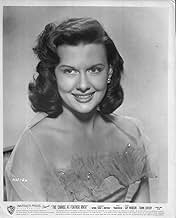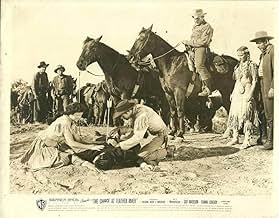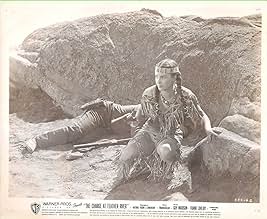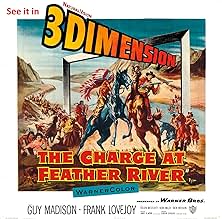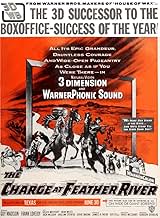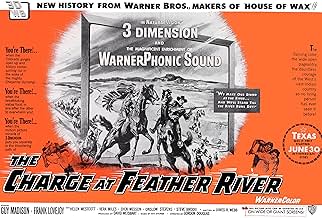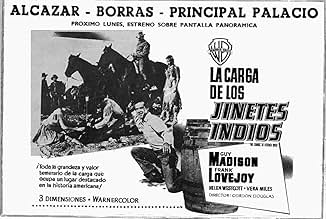NOTE IMDb
6,2/10
792
MA NOTE
Ajouter une intrigue dans votre langueIn Colorado territory, Miles Archer is asked by the cavalry at Fort Bellows to aid in rescuing two white women abducted by the Cheyenne and to provide security for the railroad construction ... Tout lireIn Colorado territory, Miles Archer is asked by the cavalry at Fort Bellows to aid in rescuing two white women abducted by the Cheyenne and to provide security for the railroad construction teams.In Colorado territory, Miles Archer is asked by the cavalry at Fort Bellows to aid in rescuing two white women abducted by the Cheyenne and to provide security for the railroad construction teams.
Avis à la une
"The Charge at Feather River" is a routine Western about the U. S. Cavalry against the Cheyenne Indians... The film carried a constantly mounting tension with some pleasant diversion...
Guy Madison and Frank Lovejoy play the officers who rescue Helen Westcott and Vera Miles from the Indians...
The outdoor scenes are well photographed, specially the exciting Indian charge at Feather River at the climax of the movie with the rain of spears, the fight to-the-death between Madison and Thunderhawk, the sketches of the Guardhouse Brigade, even a mouthful of tobacco juice used against a rattlesnake, and the romantic interludes between our hero and Helen Westcott... All are here, pictorially entertaining in 3-D and Technicolor...
Guy Madison and Frank Lovejoy play the officers who rescue Helen Westcott and Vera Miles from the Indians...
The outdoor scenes are well photographed, specially the exciting Indian charge at Feather River at the climax of the movie with the rain of spears, the fight to-the-death between Madison and Thunderhawk, the sketches of the Guardhouse Brigade, even a mouthful of tobacco juice used against a rattlesnake, and the romantic interludes between our hero and Helen Westcott... All are here, pictorially entertaining in 3-D and Technicolor...
The Charge at Feather River is directed by Gordon Douglas and written by James R. Webb. It stars Guy Madison, Frank Lovejoy, Helen Westcott, Vera Miles, Dick Wesson, Onslow Stevens, Steve Brodie, Neville Brand and James Brown. Filmed in Natural Vision-3-Dimension and WarnerColor, music is by Max Steiner and cinematography by J. Peverell Marley.
The Guardhouse Brigade.
Wonderful. It's the sort of Western you watched as a kid and it made you fall in love with the genre. It has it all, the standard Cowboys versus Indians action to keep the youngsters amused, and quality characterisations for the knowing adults to acknowledge. Plot would become very familiar over the years, where a bunch of reprobates, here they are the bad boys of the army guardhouse, are trained up and sent on a suicide mission. The mission here is to rescue two white sisters who were captured by the Cheyenne years ago.
The group dynamic positively bubbles with tension as men who fought on opposite sides of the Civil War are tasked with performing as one force. There's also a heated rivalry between two men because of a woman, and naturally there's some loose cannons in the group. Things further pick up when the two ladies are rescued and the group has to try and make it back to the fort with the whole Cheyenne tribe on their tail. The elder sister is grateful to be rescued, the younger one not so much since she has converted to the Cheyenne way and is set to marry Chief Thunder Hawk.
Thus the group dynamic goes up a couple of more notches on the stove as the younger sister does all she can to sabotage the mission, while the elder frets about how society will treat her once her past comes to light, and of course there's an attraction between her and the alpha male. Yet the romantic thread is superbly written, really mature and never cloying. There's some requisite humour that works very well, the action is very well staged by the wily Douglas and Madison makes for a good leader of men. While having Brand and Brodie in support playing ornery dudes is perfect casting.
It's a very satisfying Oater, it's not hard to see why it was a big hit at the box office. Oh for sure the 3-D gimmick would have been a big draw, especially since there's plenty of scenes made for 3-D nirvana in the picture. However, this is strong enough to stand on its own 2-D feet, a throwback to a great decade of Westerns. It also has a Steiner musical score and Marley's super photography around the California locations. Think what would happen if you mixed The Searchers and Major Dundee together, added in some Dirty Dozen like conflicts, and then sprinkled on some seasoning of Audie Murphy like Westerns, and you then get an idea of the type of film on offer here. Recommended to Western buffs. 8/10
The Guardhouse Brigade.
Wonderful. It's the sort of Western you watched as a kid and it made you fall in love with the genre. It has it all, the standard Cowboys versus Indians action to keep the youngsters amused, and quality characterisations for the knowing adults to acknowledge. Plot would become very familiar over the years, where a bunch of reprobates, here they are the bad boys of the army guardhouse, are trained up and sent on a suicide mission. The mission here is to rescue two white sisters who were captured by the Cheyenne years ago.
The group dynamic positively bubbles with tension as men who fought on opposite sides of the Civil War are tasked with performing as one force. There's also a heated rivalry between two men because of a woman, and naturally there's some loose cannons in the group. Things further pick up when the two ladies are rescued and the group has to try and make it back to the fort with the whole Cheyenne tribe on their tail. The elder sister is grateful to be rescued, the younger one not so much since she has converted to the Cheyenne way and is set to marry Chief Thunder Hawk.
Thus the group dynamic goes up a couple of more notches on the stove as the younger sister does all she can to sabotage the mission, while the elder frets about how society will treat her once her past comes to light, and of course there's an attraction between her and the alpha male. Yet the romantic thread is superbly written, really mature and never cloying. There's some requisite humour that works very well, the action is very well staged by the wily Douglas and Madison makes for a good leader of men. While having Brand and Brodie in support playing ornery dudes is perfect casting.
It's a very satisfying Oater, it's not hard to see why it was a big hit at the box office. Oh for sure the 3-D gimmick would have been a big draw, especially since there's plenty of scenes made for 3-D nirvana in the picture. However, this is strong enough to stand on its own 2-D feet, a throwback to a great decade of Westerns. It also has a Steiner musical score and Marley's super photography around the California locations. Think what would happen if you mixed The Searchers and Major Dundee together, added in some Dirty Dozen like conflicts, and then sprinkled on some seasoning of Audie Murphy like Westerns, and you then get an idea of the type of film on offer here. Recommended to Western buffs. 8/10
Other commentators here have done an admirable job in addressing where "Charge at Feather River" fits in within the canon of Western movies, its similarity to "The Dirty Dozen" and other films of that genre, the use of 3-D effects, and even the origin of the Wilhelm scream. But what about the climactic, epic-making confrontation between Miles Archer (Guy Madison) and Chief Thunderhawk (Fred Carson)? In the action/adventure movies of the 1950s and 1960s, one knows the leaders will meet and fight it out. But when and where and how will it happen?
Thunderhawk has plenty of reasons to want to kill Archer himself. The whites are building a railroad through Cheyenne territory; their rescue effort has led to the death of Thunderhawk's bride-to-be. The cavalry troopers are occupying an island in the middle of the Feather River itself.
In the first charge, the Cheyenne have been repulsed. Their bodies float about the river. Stray horses amble about without direction. But the calm following this is deceptive. The Cheyenne prepare for another charge and this time Thunderhawk will personally take command.
At first, all goes well and a couple of the Guardhouse Brigade are picked off. Then, Thunderhawk commits his fatal mistake. At the head of about thirty to fifty braves, he veers off with only a half a dozen or so warriors to approach the island from the rear while the main bunch of Indians continues to hurl spears and to get shot, falling off their horses, and then bobbing in the river.
Thunderhawk, recognizable in his eagle feather headdress, leads his handpicked braves slowly up an embankment, on their bellies, in preparation for this "stealth" attack. But when they reach the crest of the embankment, above the river's edge, all goes wrong. They are seen too soon and all but Thunderhawk get shot down. Meanwhile, the main war party is beginning to back off.
Thunderhawk, without rifle or spear, cut off from all his men, draws his knife, preparing to do battle with Archer, one against one. Thunderhawk's very life now depends upon his skill with a knife. The bare-chested Cheyenne war chief, confident, powerful, motivated, eager for revenge and victory, squares off against Archer.
After only a few moments, Archer has maneuvered the chief to a slight earthen rise above the embankment, so that the daring, risk-taking, bold Cheyenne war chief stands a little bit above the cavalry officer. Archer goes for Thunderhawk's proud, taut, copper-bronze, native leader belly. As the knife goes in (off camera), Thunderhawk grunts in disbelief and topples, about to fall over the embankment. In a very clever shot, Guy Madison is seen looking over the embankment as Thunderhawk might have seen the view, his last before his death. Thunderhawk gives out a scream of terror as he tumbles down the embankment, splashing into the river. His horse makes way, only slightly, as the chief disappears under the water.
A valiant, determined, daring, native chief has lost his gamble.
Thunderhawk has plenty of reasons to want to kill Archer himself. The whites are building a railroad through Cheyenne territory; their rescue effort has led to the death of Thunderhawk's bride-to-be. The cavalry troopers are occupying an island in the middle of the Feather River itself.
In the first charge, the Cheyenne have been repulsed. Their bodies float about the river. Stray horses amble about without direction. But the calm following this is deceptive. The Cheyenne prepare for another charge and this time Thunderhawk will personally take command.
At first, all goes well and a couple of the Guardhouse Brigade are picked off. Then, Thunderhawk commits his fatal mistake. At the head of about thirty to fifty braves, he veers off with only a half a dozen or so warriors to approach the island from the rear while the main bunch of Indians continues to hurl spears and to get shot, falling off their horses, and then bobbing in the river.
Thunderhawk, recognizable in his eagle feather headdress, leads his handpicked braves slowly up an embankment, on their bellies, in preparation for this "stealth" attack. But when they reach the crest of the embankment, above the river's edge, all goes wrong. They are seen too soon and all but Thunderhawk get shot down. Meanwhile, the main war party is beginning to back off.
Thunderhawk, without rifle or spear, cut off from all his men, draws his knife, preparing to do battle with Archer, one against one. Thunderhawk's very life now depends upon his skill with a knife. The bare-chested Cheyenne war chief, confident, powerful, motivated, eager for revenge and victory, squares off against Archer.
After only a few moments, Archer has maneuvered the chief to a slight earthen rise above the embankment, so that the daring, risk-taking, bold Cheyenne war chief stands a little bit above the cavalry officer. Archer goes for Thunderhawk's proud, taut, copper-bronze, native leader belly. As the knife goes in (off camera), Thunderhawk grunts in disbelief and topples, about to fall over the embankment. In a very clever shot, Guy Madison is seen looking over the embankment as Thunderhawk might have seen the view, his last before his death. Thunderhawk gives out a scream of terror as he tumbles down the embankment, splashing into the river. His horse makes way, only slightly, as the chief disappears under the water.
A valiant, determined, daring, native chief has lost his gamble.
After two white women are abducted and taken hostage by the Cheyenne, a frontiersman by the name of "Miles Archer" (Guy Madison) is recruited by the commander of a nearby fort to retrieve them. Accompanying him are several soldiers who have recently gotten into trouble and have been placed under his authority in order to have their punishment reduced. To complicate matters even further, a railroad is being built through Cheyenne territory and this has stirred up the local tribes as well. Now rather than going any further I will just say that this was a decent Western which had a couple of unique innovations in its favor. For starters, it was filmed in a basic version of 3D which is evidenced by the number of shots that feature arrows and spears appearing to come directly at the camera. Likewise, it also incorporated a special audio effect known as the "Wilhelm scream" which was used in a specific incident involving a soldier named "Private Wilhelm" (Ralph Brooks) being shot in the leg with an arrow and this unique sound has since been used in hundreds of other movies afterward. Additionally, having a beautiful actress like Vera Miles (as "Jennie McKeever") dressed in buckskin didn't hurt the film in any way either. Be that as it may, I found this film to be entertaining for the most part and have rated it accordingly. Slightly above average.
Absolutely superior 3D photography, possibly the best from that short-lived gimmick (saw it slack-jawed at a recent 3D Festival here in Los Angeles). Very clever and simple effects from yoeman director Gordon Douglas, who handily uses his B-movie angles to great effect in this little saga, with a flawless Guy Madison and Frank Lovejoy very, very good in their parts as rogue officers leading a ragtag band (a'la THE DIRTY DOZEN) to find (a'la THE SEARCHERS)a woman kidnapped (not exactly against her will) by Indians (the added twist: an incredibly evil performance by a likewise kidnapped sister, Vera Miles, looking like she just graduated from high school, who stops at nothing to halt the progress of Our Guys. Two stand-out scenes, even in 2D, is Lovejoy spitting INTO the camera to rid himself of a deadly snake (sounding a lot like Mel Blanc hawking up), and the first use of the infamous "Wilhelm Scream" - since used in literally hundreds of films (and actully re-mastered by Ben Buritt for LucasFilms' use - you can hear it much like that strange "oh-oh" titter in old situation comedy tracks - in all Warner Bros. films from this movie on, as well as RAIDERS OF THE LOST ARK. Listen for it (in CHARGE AT FEATHER RIVER it comes right after the inevitable "You OK, Wilhelm?" before he's ZAPPED by an arrow in the chest - one of many thrown at the audience in the film's compact running time).
Le saviez-vous
- AnecdotesWILHELM SCREAM: A scream used for the character Private Wilhelm (recorded originally for Les aventures du capitaine Wyatt (1951)), can be heard when he is shot in the leg by and arrow and painfully lets out a Wilhelm. This famous sound effect has since been re-used in many films, including the Star Wars, The Lord of The Rings and Indiana Jones films.
- GaffesWhen Morgan sets Jennie free, she takes his revolver and then falls from the cliff, taking his revolver with her. In subsequent shots, however, Morgan has a pistol again.
- ConnexionsFeatured in Une étoile est née (1954)
Meilleurs choix
Connectez-vous pour évaluer et suivre la liste de favoris afin de recevoir des recommandations personnalisées
- How long is The Charge at Feather River?Alimenté par Alexa
Détails
Box-office
- Montant brut aux États-Unis et au Canada
- 3 650 000 $US
- Durée
- 1h 35min(95 min)
- Rapport de forme
- 1.37 : 1
Contribuer à cette page
Suggérer une modification ou ajouter du contenu manquant


